by Gerrit Bester
The much-anticipated second annual GBV symposium, Canvas for Change: Creative Pathways to Eradicate Gender-Based Violence and Femicide (GBVF), took place at the Tshwane University of Technology's Faculty of Arts and Design (Research Niche Area: Artivism as a Tool to Combat Gender-Based Violence(s)) on 8 and 9 August. The event featured a diverse line-up of voices, including academics, artists, survivors, students and changemakers, who explored innovative and creative approaches to combating GBVF.
The symposium was hosted in partnership with Student Affairs and Extracurricular Development (SAED), the City of Tshwane (CoT), the South African Journal of Art History (SAJAH) and the Gauteng Department of Community Safety (GDCS).
Delegates were inspired by Prof Nalini Moodley, Executive Dean of the Faculty of Arts and Design and a passionate leader of the Research Niche Area. Her welcome address, titled Unlearning Violence, Reimagining Futures: Artivism in the Struggle Against GBV, set the tone for what was shaping up to be an impactful and transformative event.
She noted that the context in which delegates met was grim, since South Africa remained one of the most dangerous places in the world to be a woman or gender-diverse person.
“Between April and June 2024 alone, over 10 000 rapes were officially reported, with nearly 43% taking place in homes – the very space meant to protect and nurture,” she said. “Against this backdrop, the role of public universities became even more critical. We are not neutral spaces. We are custodians of democracy, stewards of knowledge and agents of social transformation, a factory if you like, for clear thinking, morally grounded future citizens.”
She added that the Faculty of Arts and Design was committed to the Artivism movement through its research niche, emphasising that creative practice is central to the struggle for justice.
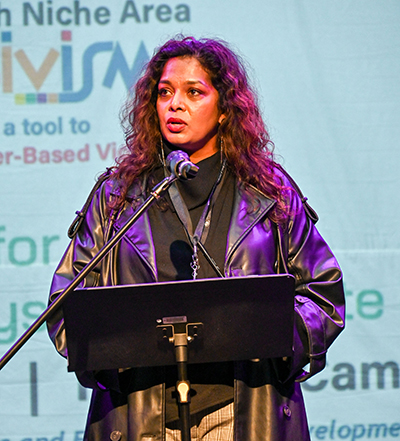
Prof Nalini Moodley, Executive Dean of the Faculty of Arts and Design and a passionate leader of the Research Niche Area, Artivism as a Tool to Combat Gender-Based Violence(s)).
Councillor Palesa Modise, Member of the Mayoral Committee (MMC) for Community and Social Development Services, City of Tshwane, said this partnership was rooted in the City’s constitutional obligation to promote social justice and uphold human dignity. She noted that art has always played a vital role in social transformation and expressed the hope that the symposium would lead to action, not just applause.
Dr Yolanda van der Vyfer, Editor in Chief of the South African Journal of Art History (SAJAH), highlighted how the depiction of GBV had changed over time. She commended Higher Education Institutions for taking on the mammoth task of addressing GBV, specifically the Arts, and announced that SAJAH looked forward to publishing contributions from this year’s symposium.
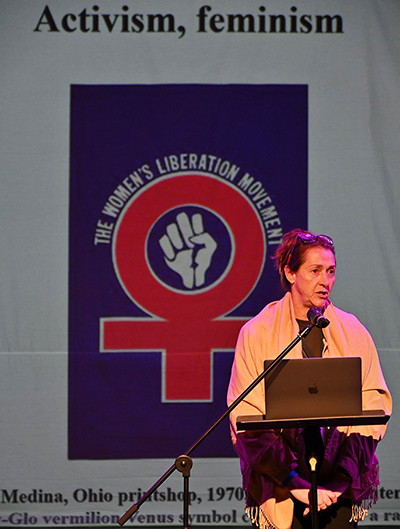
Dr Yolanda van der Vyfer, Editor in Chief of the South African Journal of Art History (SAJAH).
Dr Vathi Papu-Zamxaka, Deputy Vice-Chancellor: Research Innovation and Engagement, officially opened the symposium.
“As we convene for this symposium, we are reminded that we are not confronting a peripheral concern. GBV is not a ‘soft’ issue. It is a national crisis. And yet, in the face of such violence, this Research Niche Area dares to believe in the power of art. It dares to believe in creativity and in the related research. This is an admirable and rather radical proposition of this symposium: that the intersection of art and activism can be a powerful epistemology, a transformative methodology and indeed an urgent call to justice,” she said.
“As one of the leading institutions of technological and creative innovation, TUT has a critical responsibility to interrogate, intervene and innovate in the space of GBV. Our Research Niche Areas offer a structured and interdisciplinary framework to do just that.”
Dr Soraya Beukes, Chairperson of Higher Education and Resource Services South Africa (HERS-SA), explored the role of art students in GBV through a social justice lens in her keynote address. She said that art students are uniquely positioned to raise awareness and challenge injustice. She urged delegates to assist HERS-SA’s efforts to have the Women Empowerment and Gender Bill of 2014 enacted into law by Parliament.
One of the highlights of the symposium was a collaborative ceramic tile project centred on the theme of addressing GBV through creative practice. This project, which is part of the 100-day challenge focused on accelerating the implementation of the National Strategic Plan (NSP) to end GBVF, would consist of 100 hand-painted tiles, each painted by a symposium participant in response to this critical issue.
Dr Shadrack Nthangeni, Executive Director: Student Affairs and Extracurricular Development (SAED) and Acting Deputy Vice-Chancellor: Operations, kicked off the second day of the symposium. In his opening address, We are the generation to end GBV – Break the chain, he reminded delegates that the legacy of the women who marched in 1956 is our inheritance today.
He said the GBV scourge has cast a shadow over Women’s Day celebrations, and unfortunately, TUT has not been immune. “We have seen, heard and felt its impact in our spaces. But we are the generation to end GBV and we are resolute to break the chain.”
Albie Sachs, activist writer and former judge of the Constitutional Court of South Africa, joined the symposium online. He delved into how the Constitutional Court addressed GBV in the Carmichele and Baloyi cases.
Asked about what direction the arts should take to address GBV, he said a richer, more reflective approach to art can illuminate humanity’s contradictions. “Art can help us confront fear and hope in ways the ordinary may not.”
Delegates could view an artwork from the Constitutional Court Art Collection, The Kingdom, 2018, photographed by Elisa Iannacone ©. The Kingdom is part of The Spiral of Containment: Rape’s Aftermath series, a multi-media immersive and experiential exhibition by Mexican-Canadian photographer, cinematographer and foreign correspondent, Elisa Iannacone.
Khanyisile Zulu, who is featured in this work, described how she decided to tell her story despite being encouraged to keep quiet. “Silence gives it power.”
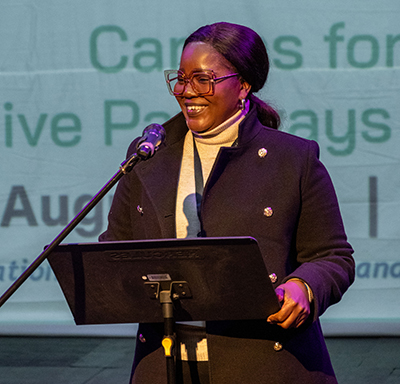
Councillor Palesa Modise, Member of the Mayoral Committee (MMC) for Community and Social Development Services, City of Tshwane.
Echoes of Silence is an installation artwork created for the symposium. It embodies the silenced voices of women – the whispers, the unspoken thoughts and the suppressed truths that demand to be heard. It was created by Caitlin Greenberg, Acting Section Head for the Department of Fine and Studio Arts and celebrated glass artist.
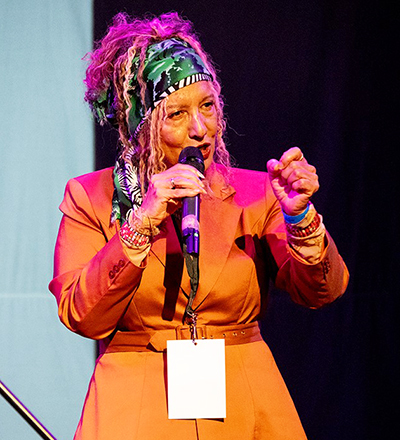
Dr Soraya Beukes, Chairperson of Higher Education and Resource Services South Africa (HERS-SA).
It was created from blown glass and mixed media to reflect the tension between fragility and strength, silence and chaos. A soundscape of superimposed female voices, speaking and colliding, echoed the inner clamour of suppressed thoughts – urgent, chaotic and yearning to be acknowledged.
Oh, and she fell in the garden, is another thought-provoking sculpture by North-West University’s Dr Louisemarié Combrink that was on display. Dr Combrink used found objects (kitchenware and toys, some broken) to create a female persona. She has a black eye, and the title Oh, and she fell in the garden refers to either excuses made by victims of GBV or lies told about how victims sustained their injuries by perpetrators of GBV.
A proud moment for Prof Moodley and Prof Chats Devroop, Research Professor at the Faculty, was when they unveiled their new book, Art as Resistance, which they co-edited. The book illuminates Artivism – the fusion of artistic practice and activism – as a transformative force that moves beyond traditional policy and disciplinary boundaries to engage with GBV through embodied knowledge production, collective healing and pedagogical transformation.
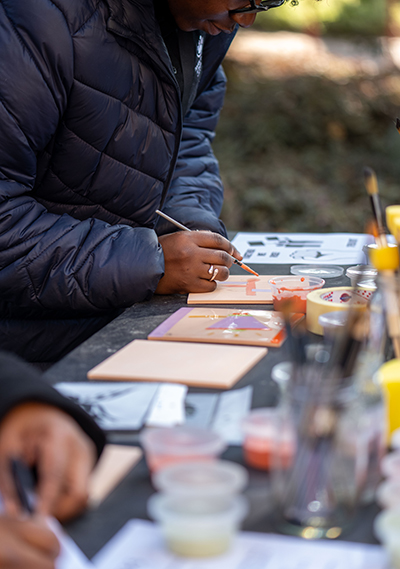
One of the highlights of the symposium was a collaborative ceramic tile project centred on the theme of addressing GBV through creative practice.
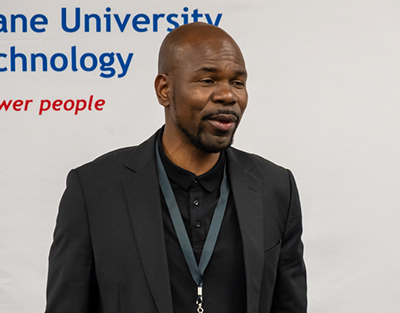
Dr Shadrack Nthangeni, Executive Director: Student Affairs and Extracurricular Development (SAED) and Acting Deputy Vice-Chancellor: Operations.
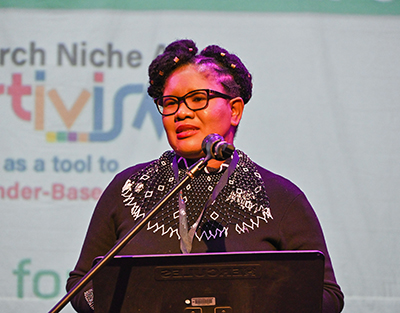
Dr Vathi Papu-Zamxaka, Deputy Vice-Chancellor: Research Innovation and Engagement.
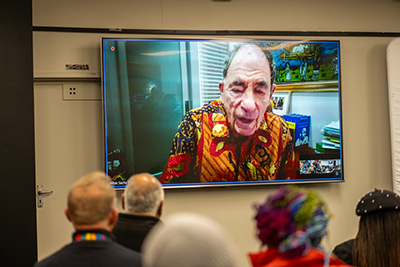
Albie Sachs, activist writer and former judge of the Constitutional Court of South Africa, joined the symposium online.
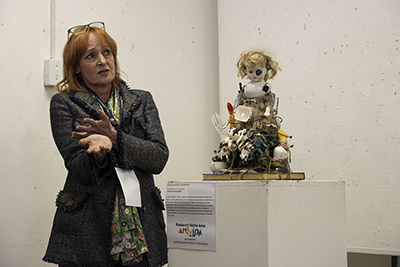
Oh, and she fell in the garden, is a thought-provoking sculpture by North-West University’s Dr Louisemarié Combrink that was on display.
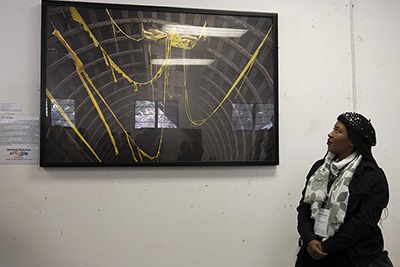
Delegates could view an artwork from the Constitutional Court Art Collection, The Kingdom, 2018, photographed by Elisa Iannacone ©. Khanyisile Zulu is featured in this work.
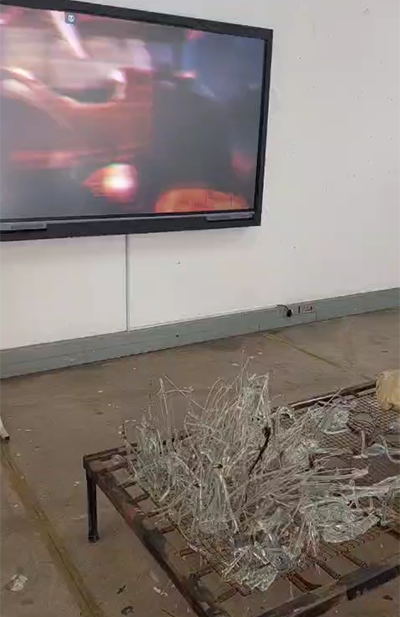
VIDEO: Please click here to access the video link.
Echoes of Silence is an installation artwork created
for the GBVF symposium. It embodies the silenced
voices of women – the whispers, the unspoken
thoughts and the suppressed truths that demand
to be heard.
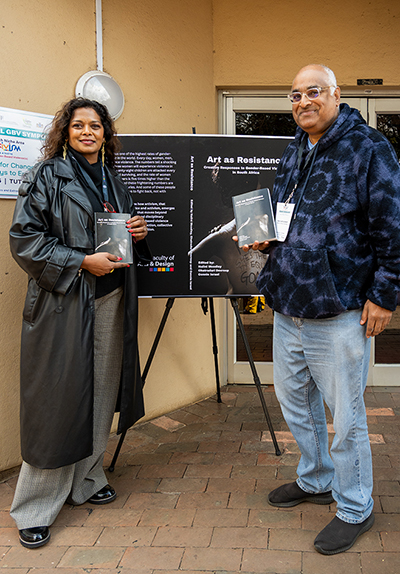
A proud moment for Prof Nalini Moodley, Execute Dean: Faculty
of Arts and Design, and Prof Chats Devroop, Research Professor
at the Faculty, was when they unveiled their new book,
Art as Resistance, which they co-edited.
PHOTOS & VIDEO: Thato Sephai, Calvin Mashabela, Yibanathi Goniwe & Gerrit Bester
